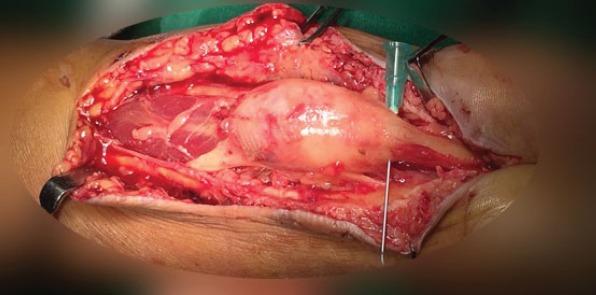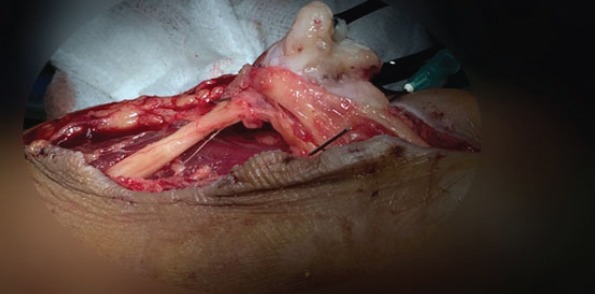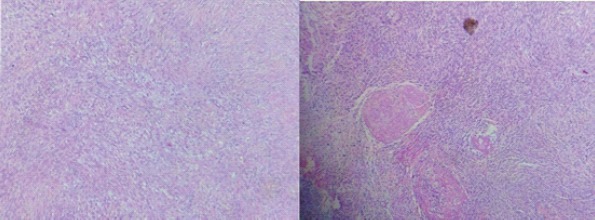Abstract
Introduction:
Neurothekeomas are uncommon benign soft tissue tumors of the peripheral nerves. It is commonly found in the upper extremities and in the head and the neck region as a small, asymptomatic, and superficial nodule.
Case Report:
We report a rare case of intraneural neurothekeoma (2.8 χ 2.4 x 1.8 cm) of the median nerve at the wrist in a 56-year-old female, which presented with clinical features of carpal tunnel syndrome.
Conclusion:
Carpal tunnel syndrome caused by intraneural neurothekeoma has been rarely reported. Clinicians should be aware of this rare cause of carpal tunnel syndrome.
Keywords: Neurothekeoma, median nerve, carpal tunnel, nerve sheath tumor, schwannoma
Learning Points for this Article.
Intranural neurothekeoma an uncommon benign soft tissue tumor of the peripheral nerves can present with symptoms of carpal tunnel syndrome.
Introduction
Neurothekeoma is an uncommon, benign tumor, thought to be a variant of a peripheral nerve sheath myxoma [1, 2]. Neurothekeomas are generally slow-growing tumor and most commonly located in the head, neck, or upper extremities as small, asymptomatic, and superficial nodule with high recurrence rate following excision [3, 4, 5].
Case Report
A 56-year-old female presented with painless swelling in volar aspect of right forearm of 2-year duration. The swelling was insidious in onset gradually increasing in size for 2 years. It was associated with tingling, numbness in the thumb, index, and middle finger with increased symptoms for 3 months. Physical examination revealed tender but firm swelling 4.5 x 1.5 cm in diameter over volar aspect of forearm extending almost to the wrist joint. On neurological examination, Tinel’s sign was positive in the distribution of median nerve, and median nerve compression test was positive at the wrist joint. Electromyography confirmed delayed nerve conduction in the median nerve. Magnetic resonance imaging (MRI) confirmed that the swelling was arising from median nerve at approximately 3 cm proximal to the carpal tunnel without involving the underlying muscles (Fig. 1).
Figure 1.
Magnetic resonance imaging showing a sharply marginated well-defined soft tissue in the volar aspect offorearms arising from the median nerve without invading the flexor muscles
The patient was operated for removal of tumor and decompression of the carpal tunnel. At surgery, after carefully dissecting the tumor and median nerve from underlying muscle, we found that the tumor was encapsulated within median nerve measuring 2.8 x 2.4 x 1.8 cm. The nerve was edematous and looking angry red (Fig. 2). The capsule was opened which revealed the grayish-white mass that was excised in total without damaging the nerve (Fig. 3) Tumorous growth was sent for histopathology. Microscopic evaluation (Fig. 4) revealed that the tumor possessed myxoid lobulated lesions. Immunohistochemical staining revealed that the tumor cells were positive for S100 while negative for CD34, desmin, and smooth muscle actin. Based on these histopathological and immunohistochemistry results [6], the present case was diagnosed as neurothekeoma. Following surgery, the patient had complete improvement of symptoms at 1-month follow-up and no recurrence at 18-month follow-up.
Figure 2.

Intra-operative image showing the tumor arising from median nerve with a needle marking the dorsal extent oftumor distally.
Figure 3.

Intra-operative image showing grayish-white tumor mass after incision on the tumor capsule
Figure 4.

Microscopic image of the tumor showing myxoid lobulated lesions. (Hematoxylin and Eosin stain x100).
Discussion
Neurothekeoma is rare benign cutaneous tumor originating from endoneurium of peripheral nerve. Initially, it was termed as myxoma of nerve sheath by Harkin and Reed in 1969 [7, 8]. Neurothekeoma is most commonly seen in upper extremity (33.6%) followed by the head, neck (29%), scalp, orbital region, cheeks, and chin and is a rare finding in the lower extremity. Most patients of neurothekeoma develop lesions before the age of 30 years, and these are more commonly seen in females. It is a rare finding in children below the age of 10 [3]. On extensive literature search, there is only one other case report of neurothekeoma of the median nerve [8].
On physical examination, neurothekeomas appear as asymptomatic to mildly tender, solitary nodules. These nodules are normally small, but sometimes, it can present in larger sizes. Histologically, these tumor cells are epithelioid to spindle in shape with abundant pale eosinophilic cytoplasm, oval nuclei with pinpoint nucleoli. They are histologically divided into myxoid, intermediate, and cellular types based on the amount of myxoid matrix present. Myxoid variant of neurothekeoma is of neural origin. S100 A6, which is a member of the S100 protein family, has been demonstrated to have very high sensitivity for cellular neurothekeoma [9]. Confirmation of the diagnosis of neurothekeoma is based on MRI followed by biopsy. Neurothekeomas should be differentiated clinically from lesions such as epidermal inclusion cysts, intradermal nevi, lipomas, pilomatrixomas, or dermatofibroma. Histologically, they must be differentiated from other fibrohistiocytic tumors such as plexiform fibrohistiocytic tumor or fibromyxoma, lymphocytic lesions, neurofibromas, and melanocytic lesions [10].
Lesions with size >6 cm, involving subcutaneous tissue, muscle, or the vessels, with cytologic pleomorphism are considered atypical neurothekeoma [11]. Neurothekeomas were originally termed myxoma of the nerve sheath, but now, they are separate and distinct from nerve sheath myxomas. Unlike neurothekeomas, nerve sheath myxomas are commonly present in the fourth decade; although they have similar gender ratios, they are most commonly seen in the extremities, particularly hand. Neurothekeomas have a high tendency of local recurrence and characteristically show a strong immunoreactivity for S100 protein. Treatment of neurothekeoma consists of complete surgical excision. Occasional recurrence has been reported; however, these have generally been reported from remnant tissue due to incomplete excision [11]. Neurothekeoma mostly presents in the upper extremity; they should be differentiated from other soft tissue tumors of upper extremities.
Conclusion
Carpal tunnel syndrome is a common medical syndrome due to compression of the median nerve at wrist and in the carpal tunnel. Carpal tunnel syndrome caused by intraneural neurothekeoma has been rarely reported. Clinicians should be aware of this rare cause of carpal tunnel syndrome.
Clinical Message.
Neurothekeoma is rare benign cutaneous tumor commonly located in the head, neck, or upper extremities. Intraneural neurothekeoma is very rare presentation. Diagnosis is mainly based on MRI and histopathology in these cases. Treatment of neurothekeoma consists of complete surgical excision. Occasional recurrence has been reported; however, these have generally been reported from remnant tissue due to incomplete excision.
Biography



References
- 1.Isoda M, Katayama M. Neurothekeoma. Cutis. 1988;41:255–6. [PubMed] [Google Scholar]
- 2.Gallager RL, Helwig EB. Neurothekeoma-a benign cutaneous tumor of neural origin. Am J Clin Pathol. 1980;74:759–64. doi: 10.1093/ajcp/74.6.759. [DOI] [PubMed] [Google Scholar]
- 3.FetschJF Laskin WB, Miettinen M. Nerve sheath myxoma:A clinicopathologic and immunohistochemical analysis of 57 morphologically distinctive, S-100 protein- and GFAP- positive, myxoid peripheral nerve sheath tumors with a predilection for the extremities and a high local recurrence rate. Am J Surg Pathol. 2005;29:1615–24. doi: 10.1097/01.pas.0000173025.87476.a4. [DOI] [PubMed] [Google Scholar]
- 4.Yang YW, Shih IH, Huang YH, Kuo TT, Hong HS. Mixed- type neurothekeoma presenting with an unusual clinical appearance of multiple satellite lesions on the back. Dermatol Surg. 2005;31:720–2. doi: 10.1111/j.1524-4725.2005.31623. [DOI] [PubMed] [Google Scholar]
- 5.Barnhill RL, Dickersin GR, Nickeleit V, Bhan AK, Muhlbauer JE, Phillips ME, et al. Studies on the cellular origin of neurothekeoma:Clinical, light microscopic, immunohistochemical, and ultrastructural observations. J Am Acad Dermatol. 1991;25:80–8. doi: 10.1016/0190-9622(91)70177-4. [DOI] [PubMed] [Google Scholar]
- 6.Fetsch JF, Laskin WB, Hallman JR, Lupton GP, Miettinen M. Neurothekeoma:An analysis of 178 tumors with detailed immunohistochemical data and long-term patient follow-up information. Am J Surg Pathol. 2007;31:1103–14. doi: 10.1097/PAS.0b013e31802d96af. [DOI] [PubMed] [Google Scholar]
- 7.Harkin J, Reed R. Tumors of the peripheral nervous system. In: Harkin JC, Reed RJ, editors. Atlas of Tumor Pathology. Washington, DC: Armed Forces Institute of Pathology; 1969. [Google Scholar]
- 8.Fanto SA, Fanto E. Neurothekeoma of the median nerve:Case report. J Hand Surg Am. 2012;37:1184–6. doi: 10.1016/j.jhsa.2012.03.005. [DOI] [PubMed] [Google Scholar]
- 9.Plaza JA, Torres-Cabala C, Evans H, Diwan AH, Prieto VG. Immunohistochemical expression of S100A6 in cellular neuro the keo ma:Clini copathologic and immunohistochemical analysis of 31 cases. Am J Dermatopathol. 2009;31:419–22. doi: 10.1097/DAD.0b013e3181a13afc. [DOI] [PubMed] [Google Scholar]
- 10.Papadopoulos EJ, Cohen PR, Hebert AA. Neurothekeoma:Report of a case in an infant and review of the literature. J Am Acad Dermatol. 2004;50:129–34. doi: 10.1016/s0190-9622(03)00886-7. [DOI] [PubMed] [Google Scholar]
- 11.Benbenisty KM, Andea A, Metcalf J, Cook J. Atypical cellular neurothekeoma treated with Mohs micrographic surgery. Dermatol Surg. 2006;32:582–7. doi: 10.1111/j.1524-4725.2006.32120.x. [DOI] [PubMed] [Google Scholar]



